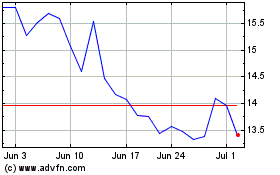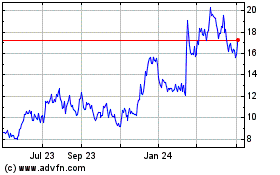GM's Operating Profit Hurt by China Results, U.S. Production Cuts --Update
April 30 2019 - 10:03AM
Dow Jones News
By Mike Colias
General Motors Co.'s operating profit declined 11% in the first
quarter, dragged down by weaker results in China and a planned cut
in production of big sport-utility vehicles in the U.S.
GM said its operating profit for the January-through-March
period totaled $2.3 billion, down from $2.6 billion a year earlier.
Operating earnings per share were $1.41, surpassing Wall Street
analysts' average estimate of $1.10 per share.
Those results were lifted 31 cents by revaluations of GM's stake
in ride-hailing firm Lyft Inc., which it took in early 2016, and
French auto maker PSA Group. GM marked up the value of its stake in
Lyft, which had climbed higher than what was previously recorded on
GM's books following the ride-hailing firm's IPO last month.
Net income more than doubled, to $2.16 billion, from a year
earlier when GM recorded hefty restructuring charges in South
Korea. First-quarter revenue fell 3%, to $34.9 billion.
GM shares dropped about around 3% in premarket trading.
GM executives said in January that the first quarter would be
its weakest of the year, partly because of its plan to temporarily
stop building big, high-margin SUVs at the company's factory in
Arlington, Texas, to prepare the facility to make new versions.
Production at the plant, which makes the Chevrolet Suburban,
Cadillac Escalade and other SUVs, fell 27% during the quarter,
according to an estimate from WardsAuto.com
The results show that GM's bottom line is increasingly reliant
on its highly profitable pickup truck and large-SUV lines,
especially as profits from its sizable operation in China ebb amid
an industry wide slowdown in the Chinese auto market. GM's
first-quarter income from China fell 37% from a year earlier, to
$376 million.
Auto-industry sales in China dropped last year for the first
time in more than two decades and sank another 11% in the first
quarter, while GM's declined nearly 18%.
GM finance chief Dhivya Suryadevara said there are "green
shoots" in China that point to improved economic activity, though
that hasn't translated to a rebound in vehicle sales. She said GM
still believes the market could be "roughly flat" for the year --
which would require growth over the remaining three quarters -- but
said that would depend on whether Beijing provides consumer
incentives for auto purchases.
In January, GM said its 2019 profit forecast factored in flat
industry-wide sales in China, the company's largest market by
sales. Ms. Suryadevara reiterated GM's full-year profit forecast of
$6.50-$7 earnings per share, versus $6.54 last year.
GM is reaping stronger pricing in the U.S., especially on its
pickup trucks. This factor also helped propel rival Ford Motor
Co.'s profits higher last week when it reported first-quarter
earnings. Detroit auto makers dominate the market for big pickup
trucks and similar large SUVs, categories that contribute the vast
majority of global profits for both GM and Ford, analysts
estimate.
Buyers paid an average of around $48,000 for GM's large pickup
trucks -- the Chevrolet Silverado and GMC Sierra -- up about 20%
during the quarter following a redesign of those models. That
pricing power helped to offset the decline in production of its big
SUVs, Ms. Suryadevara said.
GM was the subject of criticism from President Trump in March
over its closure of a factory in Lordstown, Ohio.
On Tuesday, the company said the broader restructuring effort
that included the plant closure, along with thousands of layoffs
among salaried workers, boosted the first-quarter bottom line by
roughly $400 million, Ms. Suryadevara. The company has said it
expects the moves to help operating profit by $2 billion to $2.5
billion this year.
GM Chief Executive Mary Barra has described the effort as a
transformation of GM as it pushes into new areas like self-driving
cars that are rife with new competition from well-funded Silicon
Valley newcomers.
On Tuesday, Ms. Suryadevara reiterated GM's target of launching
a commercial ride-hailing service by the end of 2019 if it can be
deployed safely. GM spent about $200 million on its San
Francisco-based Cruise driverless-car division in the first quarter
and plans to spend about $1 billion total this year as it hires
hundreds more employees.
Write to Mike Colias at Mike.Colias@wsj.com
(END) Dow Jones Newswires
April 30, 2019 09:48 ET (13:48 GMT)
Copyright (c) 2019 Dow Jones & Company, Inc.
Lyft (NASDAQ:LYFT)
Historical Stock Chart
From Mar 2024 to Apr 2024

Lyft (NASDAQ:LYFT)
Historical Stock Chart
From Apr 2023 to Apr 2024
